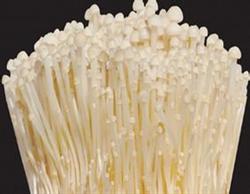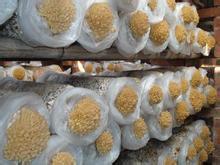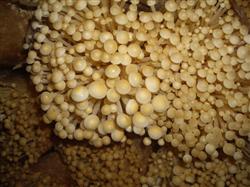High-yield cultivation techniques of Flammulina velutipes in Northeast China

Flammulina velutipes is a kind of high-grade food in edible fungi with high nutrition and health care value. at present, it has become a necessary raw material in hot pot in our region and is welcomed by the majority of consumers. In order to further improve the yield and quality of Flammulina velutipes, according to years of personal practice, the technical points of high-yield cultivation of Flammulina velutipes were summarized for reference to bacterial farmers. 1. Strain production 1. Variety selection at present, there are many varieties of Flammulina velutipes in various parts of the country. We have selected new varieties of Flammulina velutipes that are suitable for local high yield-"Flammulina velutipes No. 1" and "Golden Needle f03". Its yield, quality and stress resistance are better than other varieties, and its biological efficiency reaches 100%, which increases by 10% and 15% compared with ordinary varieties. 2. The original culture medium sawdust 78%, wheat bran 20%, white sugar 1%, gypsum 1%, water content 60%. 3. Cultivation medium (1) sawdust 84%, wheat bran 15%, gypsum 1%, water content 60%. (2) sawdust 50%, corncob 34%, wheat bran 15%, gypsum 1%, water content 60%. Each bag (17 cm x 33 cm HDPE) contains 0.9 kg. 4. Sterilize the second and third species in bottles, sterilize for 2 hours under 1.5lb pressure and keep for 8 hours at atmospheric pressure for 100℃. The cultivation bag was sterilized under atmospheric pressure for 100 ℃ and kept for 12 hours. 5. The cultivation of bacteria and cultivation bags are mainly the management of temperature and light, avoiding light in the stage of mycelium growth and regular ventilation. The mycelial growth temperature of Flammulina velutipes is 8 ℃-32 ℃, the most suitable is 20 ℃-25 ℃, the fruiting body growth is 5 ℃-18 ℃, and the most suitable is 10 ℃-14 ℃. It is difficult to form fruiting body when it exceeds 22 ℃. Second, cultivation method 1. The preparation of excellent strains requires that the hyphae grow healthily and the hyphae are just full of non-aging strains. 2. Flammulina velutipes is a kind of low temperature variety in the best cultivation season. In the case of no artificial temperature control, we should make full use of the natural temperature. Mastering the cultivation season is an important key to promote high yield. According to the natural temperature of our province, it is suitable to cultivate from September of the first year to the end of February of the second year, and the yield is the highest from October to November. 3. Using high quality raw materials and the best formula (1) cottonseed shell 80%, wheat bran 15%, calcium superphosphate 2%, gypsum 2%, sucrose 0.7%, urea 0.3%. (2) 70% cottonseed hull, 20% wheat bran and 10% sawdust. (3) sawdust 75%, wheat bran 20%, calcium superphosphate 2%, gypsum 2%. (4) corncob 50%, soybean straw powder 20%, wheat bran 20%, calcium superphosphate 5%, gypsum 2%, urea 1%. 4. There are many cultivation methods of Flammulina velutipes in bag sterilization, and the cultivation effect of plastic bag is better. After fully mixing the formula of various raw materials, it can be bagged when the water content reaches 65%. Each bag is 12 cm high, requiring uniform force, suitable tightness, not too loose and tight, flattening the surface, leaving a space of 20 cm at the top to facilitate the growth of the fruit body. In order to make the bacteria age consistent and produce mushrooms quickly, the holes were pierced in the center of the material to the bottom of the material, and then sealed with a non-cotton cover body for sterilization. Pay attention to handle it gently to prevent the plastic bag from being damaged. If there is any damage, it can be patched with adhesive tape. 5. Sterilization and inoculation sterilization methods can be sterilized under high pressure and atmospheric pressure. If the production volume is large, it can be kept for 12 hours when the material temperature reaches 100℃-110℃, and the material temperature can be naturally reduced to less than 20 ℃ before inoculation. If the natural temperature is high during vaccination, the contamination rate of miscellaneous bacteria will be high, so the inoculation box must be used in the inoculation room after drug disinfection and sterilization, especially when the bacteria and tools are scrubbed and sterilized with 75% alcohol. Each bottle of bacteria can be connected with 25ml 30 bags, and after that, cover the mouth for germ culture. 6. Mycelium culture the mycelium culture of Flammulina velutipes cultivation bag is mainly temperature management. Although it can grow at 8 ℃-32 ℃, it grows best at 20 ℃-23 ℃. When sending bacteria, it is necessary to prevent the bag from accumulating too high and too dense to produce temperature, resulting in high temperature and heat injury, and at the same time to solve the phenomenon of too low temperature. Dark light culture must be used in the process of mycelium growth, one is that excessive light can inhibit the growth of mycelium, and the other is that the mycelium does not reach physiological maturity, and the yield and quality of mushroom will be affected prematurely when the surface of culture medium is stimulated by light. Dark light culture in the mycelium growth stage is beneficial to the concentration of nutrition and neatness of mushroom production. 7. after more than 20 days of cultivation, the mycelium has grown all over the bag, and when the natural temperature is suitable for the growth of Flammulina velutipes, the mouth of the bag should be untied immediately, which is beneficial to the formation of the fruiting body. Especially after opening the bag, the newspaper or cloth should be covered on the mouth of the bag in time, otherwise, the culture medium will lose water on the surface and affect the formation of mushroom buds. 8. Mushroom management after the Flammulina velutipes bag is opened, the room should add a certain amount of light and humidity, but not direct sunlight. Spray water on newspapers or cloth every day to keep the space relative humidity at 85% Mak 95% and the space temperature 7 ℃-18 ℃. 3Mushroom buds can appear after 5 days. When spraying water, do not spray water directly on the mushroom body, so as not to cause diseases such as mushroom decay, black root and spots. After 15 days of management, the stalk of Flammulina velutipes can grow into the mouth of the bag, and the stalk can be harvested by 15 cm long. 9. Flammulina velutipes should be harvested in time after it is ripe, otherwise the stalk is easy to change color and rot. The standard of maturity is that the cap has begun to expand. If the cap is rolled up at the edge, it shows that it is fully mature and the quality is reduced. When picking, each bag of Flammulina velutipes is picked together, hold the base of the stalk with your hand, gently shake it, and then cut off the culture material glued to the base of the stalk and put it neatly in the basket for sale. 10. After each batch of Flammulina velutipes is harvested, it is necessary to remove the old fungus skin, mushroom root, dead mushroom, etc., scrape off the surface of the material and cover it with a newspaper or cloth, stop spraying water for 5 days, and then manage it in accordance with the above-mentioned methods, so as to promote the formation of the second batch of mushrooms as soon as possible. The yield of Flammulina velutipes is mainly high in the first batch, accounting for 50% of the total output, and the second and third batches of mushrooms gradually decrease. If the medium is too dehydrated and dry in the later stage, a small amount of water can be sprayed in the bag, which is beneficial to increase production.
- Prev

Protected cultivation Technology of Flammulina velutipes
The main cultivated varieties of Flammulina velutipes in China are divided into yellow Flammulina velutipes and white Flammulina velutipes, among which white Flammulina velutipes has been widely cultivated in factory, but Flammulina velutipes is mainly cultivated in agriculture. The annual cultivation technology of facilities has not been completely solved, so we can only use high altitude areas for out-of-season cultivation.
- Next

Five methods of Water Management of Flammulina velutipes at fruiting stage
Flammulina velutipes is not only a delicious food, but also a good health food. Flammulina velutipes has an increasingly broad market at home and abroad. However, the requirements of cultivation and management of Flammulina velutipes are higher, especially for the development of fruiting body. Now China Agricultural Technology Network introduces the method of water management for reference. Moisturizing and promoting buds. When the mycelium reaches the bottom of the bag.
Related
- Fuxing push coffee new agricultural production and marketing class: lack of small-scale processing plants
- Jujube rice field leisure farm deep ploughing Yilan for five years to create a space for organic food and play
- Nongyu Farm-A trial of organic papaya for brave women with advanced technology
- Four points for attention in the prevention and control of diseases and insect pests of edible fungi
- How to add nutrient solution to Edible Fungi
- Is there any good way to control edible fungus mites?
- Open Inoculation Technology of Edible Fungi
- Is there any clever way to use fertilizer for edible fungus in winter?
- What agents are used to kill the pathogens of edible fungi in the mushroom shed?
- Rapid drying of Edible Fungi

